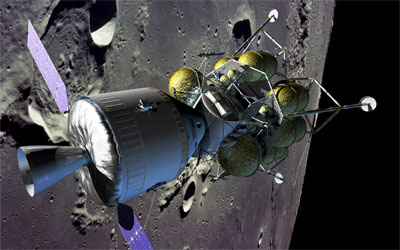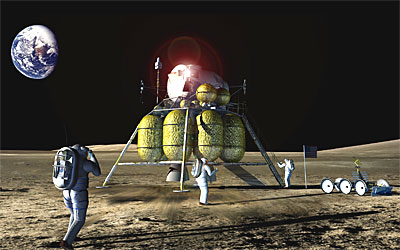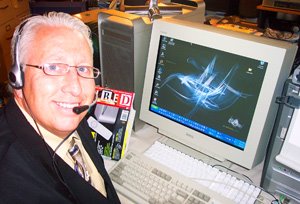Next Generation Spacecraft!
Before the end of the next decade, NASA astronauts will again explore the surface of the moon. And this time, we're going to stay, building outposts and paving the way for eventual journeys to Mars and beyond. There are echoes of the iconic images of the past, but it won't be your grandfather's moon shot.
This journey begins soon, with development of a new spaceship. Building on the best of Apollo and shuttle technology, NASA's creating a 21st century exploration system that will be affordable, reliable, versatile, and safe.

The centerpiece of this system is a new spacecraft designed to carry four astronauts to and from the moon, support up to six crewmembers on future missions to Mars, and deliver crew and supplies to the International Space Station. The new crew vehicle will be shaped like an Apollo capsule, but it will be three times larger, allowing four astronauts to travel to the moon at a time.

Coupled with the new lunar lander, the system sends twice as many astronauts to the surface as Apollo, and they can stay longer, with the initial missions lasting four to seven days. And while Apollo was limited to landings along the moon's equator, the new ship carries enough propellant to land anywhere on the moon's surface.Once a lunar outpost is established, crews could remain on the lunar surface for up to six months. The spacecraft can also operate without a crew in lunar orbit, eliminating the need for one astronaut to stay behind while others explore the surface.
With a minimum of two lunar missions per year, momentum will build quickly toward a permanent outpost. Crews will stay longer and learn to exploit the moon's resources, while landers make one way trips to deliver cargo. Eventually, the new system could rotate crews to and from a lunar outpost every six months.
Planners are already looking at the lunar south pole as a candidate for an outpost because of concentrations of hydrogen thought to be in the form of water ice, and an abundance of sunlight to provide power.
Note from Technophile: These plans give NASA a huge head start in getting to Mars. We will already have the heavy-lift system needed to get there, as well as a versatile crew capsule and propulsion systems that can make use of Martian resources. A lunar outpost just three days away from Earth will give us needed practice of "living off the land" away from our home planet, before making the longer trek to Mars. As President Bush said when he announced the Vision for Space Exploration, "Humans are headed into the cosmos." Now we know how we'll get there.Source: [NASA]. Image credits: Artist's concept by John Frassanito and Associates. Keywords: [moon], [nasa], [mars], [astronauts], [spacecraft]




















0 Comments:
Post a Comment
<< Home